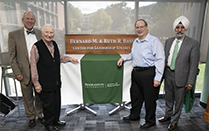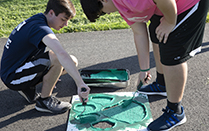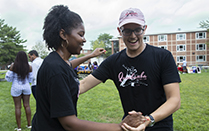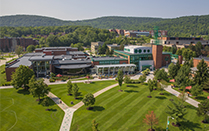Media and Public Relations
It was another productive quarter for the Media and Public Relations Office. National broadcast and print outlets, ranging from ABC News to Huffington Post, highlighted Binghamton in recent months, spreading the word about the University to millions of viewers, readers and listeners. Also, the video team had the opportunity to interview high-profile alums, ranging from Tony Kornheiser ‘70 to Jenna Wolfe ‘96 to Charles Kim ‘98.
Binghamton in the news
Fossils Suggest Common Hearing Patterns Among Humans and Chimpanzees
Two million years ago, hominins heard the world very differently from modern humans, according to a new study led by researchers Assistant Professor of Anthropology Rolf Quam. Quam and an international research team analyzed the fossilized ear bones of two early hominins from South Africa, A. africanus and P. robustus, which lived 3.3 million and 1.8 million years ago. With computerized tomography scans, the team was able to virtually reconstruct the hominins’ ears and estimate their auditory abilities. Findings indicate that the hominins’ hearing pattern resembled chimpanzees, but with some slight differences in the direction of humans. This research was featured in Nature World News, The New York Times, The Christian Science Monitor, The Conversation, The Daily Mail, Yahoo! and more. Total circulation: 300 million.
Brewing merger and Monsanto’s growth plans—5 things to know today
And one of the five things was M. Stanley Whittingham, distinguished professor of chemistry and materials science and director of the Institute for Materials Research, who was in the running for the Nobel Prize in Chemistry as a result of his pioneering research leading to the development of the lithium-ion battery. This news was featured in Fortune, Yahoo!, The Huffington Post, Finance, Medical Daily, ABC News, CNBC, Scientific American and Money. Total Circulation: 340 million.
The Message You Send When Your Text Reply Ends in a Period
In the journal Computers in Human Behavior, researchers led by Associate Professor of Psychology Celia Klin reported that college students perceive text messages that end with a period to be less sincere than ones that do not. Data indicates that people are able to include in their texts the types of non-verbal cues that are present in face-to-face conversation.” The team’s work was featured in numerous publications, including The Washington Post, Wired, Mashable, ABC News, The Huffington Post, The Pacific Standard, The TODAY Show, Yahoo! and many more. Total Circulation: 723 million.
Eocene temperature spike caused by half as much CO2 as once thought
Tim Lowenstein, geologist at Binghamton University, was recognized in Science News, Mirror Daily and The Business Standard for his research relating to the earth’s climate, which may be more sensitive to increased CO2 than currently thought. In 2015, CO2 levels have reached 400 ppm and are on track to top 800 ppm by the end of the century. Current projections say that doubling CO2 will result in a 3-degree rise in global average temperature. The new work suggests that that prediction significantly underestimates the impact of greenhouse warming, Lowenstein says. Total Circulation: 24 million.
Top Colleges Doing the Most for Low-Income Students
Binghamton University was ranked #35 in a New York Times article titled “Top Colleges Doing the Most for Low Income Students.” To measure top colleges’ efforts on economic diversity, The Upshot created the College Access Index, based on the share of students who receive Pell grants (which typically go to families making less than $70,000); the graduation rate of those students; and the price that colleges charge both low- and middle-income students. Total Circulation: Over 1.8 million; including 1.1 million digital.
University professor hunts hedgehogs to cure cancer
Brian Callahan, assistant professor of biological chemistry, was recognized in the International Business Times for his research relating to hunting hedgehog proteins to cure cancer or to effectively prevent uncontrolled cancer cell growth in the human body. He wants to develop a therapy that can kill the disease without negatively affecting the patient. Total Circulation: 5 million.
Future Technology: 22 Ideas About to Change Our World
Sarah Laszlo, assistant professor of psychology and linguistics, and Zhanpeng Jin, assistant professor of electrical and computer engineering, were recognized for their research, which outlines how our brains react to words, in several high-profile publications, including Focus: Science and Technology, Mother Nature Network and Digital Trends. Total Circulation: 22 million.
Research into the ways in which men and women recover from breakups differently, conducted by conducted by Craig Morris, research associate and Chris Reiber, associate professor, both in the Department of Anthropology, were featured in several high-profile publications, including Psychology Today. Total Circulation: 603,558.
Latest innovation can be game changer for flexible electronics, solar cells
A team of Binghamton University scientists, including Jeffrey Mativetsky and Austin Faucett, have come up with a new research idea that could revolutionize flexible electronics and solar cells, demonstrating an eco-friendly process that enables unprecedented spatial control over the electrical properties of graphene oxide, as highlighted by Yahoo!, Tech Times and The TeCake. Total Circulation: Over 2 million.
These two reasons explain why the Islamic State attacked France now
Craig Klein, PhD candidate in political science , was featured in The Washington Post for his article outlining the Islamic attack on Paris and its timing. He claimed that the Islamic State needs new recruits and that Francoise Hollande was politically weakened. Total circulation: Over 464,000
Social media
The University’s social media team published a wide variety of content — photos, videos, impressive rankings, big news stories and more — and saw heavy engagement on all of its channels. The University had several widely popular posts during the quarter. For example, a Facebook post announcing M. Stanley Whittingham, distinguished professor of chemistry and of materials science, as a potential Nobel Prize winner reached more than 106,000 people. The team also promoted the #BingPride hashtag to encourage members of the University community to share what makes Binghamton great.
During the quarter, the University surpassed 45,000 followers on Facebook, 10,000 followers on Instagram and 74,000 followers on LinkedIn. The University’s Snapchat account saw an increase in followers and views, with some posts garnering a view count of 900+.
Blog
The Binghamton University Blog published 11 blog posts, on topics ranging from safety to residential life to holidays. “13 Hidden Gems on Binghamton University’s Campus,” a post about campus locations off the beaten path, had a reach of over 63,800 on Facebook.
Other posts published this quarter include:
· “B-Safe: An Overview Of Safety At Binghamton University”
· “Haunted Binghamton: Tales Of Campus Ghosts And Ghouls”
· “8 Clubs At Binghamton You Probably Didn’t Know About”
· “Your Home Away From Home: An Inside Look At The 6 Amazing Communities At Binghamton University”
Ask a Scientist
A total of nine “Ask a Scientist” columns were published in the Press & Sun-Bulletin throughout the quarter. Faculty, staff and graduate students from across various schools and departments at Binghamton contributed answers to questions ranging from “Why don’t grown-up teeth grow back in?” to “How do plants in the rainforest get enough carbon dioxide to live without people?”
Video
Loving Binghamton University is effortless. In this episode of The Binghamton Buzz – Episode 25 – Binghamton Favorites, we ventured out to ask students what qualities they embrace the most about campus.
Tony Kornheiser ‘70 (Pardon the Interruption) - #BingPride PSA: Watch this important (and mostly hilarious!) message regarding our beloved Bearcat from ESPN’s Parton the Interruption host Tony Kornheiser ‘70.
The New Biometric: Brainprint: New technology being developed by research collaborators Sarah Laszlo and Zhanpeng Jin has delivered stunning results over the ability to identify human beings through brain scans. Learn more about the science behind this fascinating work!
Binghamton University’s Challenge Course provides groups with a unique bonding experience, enhancing community building through physical and mental challenges. Course staff and participants speak to the importance of teamwork and how the program prepares students for future endeavors.
Increased Prevalence of Ticks in Built Environments: An alarming increase in the number of deer ticks in Upstate New York sparked Professor of Biomedical Anthropology Ralph Garruto to involve graduate and undergraduate students in further exploring tick densities and infection rates in and around Broome and Chenango counties.
What better reason to wake up before a sunrise? To run with Binghamton University President Harvey Stenger, of course. Sleepy-eyed and unaware of the distance, our host Trey tags along with students for a morning run to become more acquainted with President Stenger. Join President Stenger and Trey for a morning run: The Binghamton Buzz - Episode 24 – Running With The President.
The Zombie Nation video was introduced around Halloween. Explore the first-ever University-level zombie course: Zombie Nation. If you’re an undead aficionado, this course has your name written all over it. You might be surprised, however, at some of the real-world issues students in this course are tackling.
Decker School of Nursing Overview: Binghamton University’s Decker School of Nursing prides itself on both the quality and the quantity of its clinical practice experiences, which are seen as the foundation for graduates’ success in professional practice. Students reflect on their journey as they advance their education, further exploring opportunities provided by the Decker School.
Who is Al Vos? Meet Al Vos: Binghamton University Faculty Master. Not only is he Binghamton University’s longest-serving faculty master; he is an icon, adored by many students. In this video, Al speaks to the enriching experience his role provides him at Hinman College.
Learn more about 2-Million-Year-Old Fossils Reveal Hearing Abilities of Early Humans: Rolf Quam, assistant professor of anthropology, conducted research into human fossils dating back to approximately two million years ago to reveal how the hearing pattern resembles chimpanzees, but with some slight differences in the directions of humans. Quam led an international research team in reconstructing an aspect of sensory perception in several fossil hominin individuals from the sites of Sterkfontein and Swartkrans in South Africa.
High-profile University/President Harvey Stenger activities
President Harvey Stenger was once again in the spotlight as co-chair of the Southern Tier’s REDC. The winners of the CFA Round V and the Upstate Revitalization Initiative (URI) were announced in Albany on Thursday, Dec. 10. The Southern Tier REDC was one of the three “big” winners, which means the region will receive $500 million dollars over the next five years to spur economic development projects.
Stenger went to Albany, and was on stage with the Governor and the entire STREDC team when the award was presented. Following the event in Albany, Stenger returned to campus to hold a news conference, again with the REDC team and elected officials, to provide reaction for the media and to talk about next steps.
Prior to the award, Stenger had to travel to Albany on Oct. 20, again with the STREDC leadership, to present the region’s strategic plan to the State’s Site Assessment Review Panel. Stenger, as co-chair of the STREDC, was one of the main presenters. He and co-chair Thomas Tranter, of Corning, as well as others from the region, described our URI plan, which targets four specific strategies;
• Build the Greater Binghamton Innovation Ecosystem
• Invest in the Advanced Manufacturing Industry
• Transform the Food and Agriculture Industry
• Promote the Southern Tier’s Innovative Culture
This was the plan that won the region the $500 million prize.







